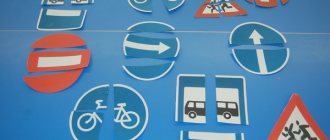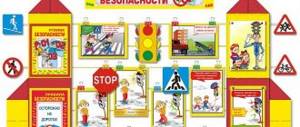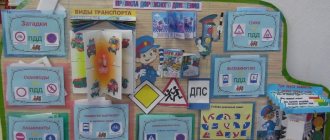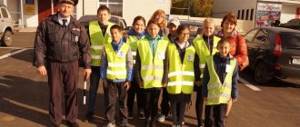Road safety is one of the hot topics because road accidents occur at any time of the year. And one of the reasons is children’s ignorance and non-compliance with traffic rules. Therefore, parents and teachers should convey to preschoolers information about the importance of following the rules of behavior on the road. For this purpose, an appeal is being made to parents of preschool children on traffic rules, dedicated to this topic, and traffic police officers are invited. It is important that the child realizes the need for correct behavior on the road as early as possible.
Information for parents about traffic rules in preschool educational institutions
Some parents believe that preschoolers should be introduced to traffic rules closer to school. But this opinion is erroneous: after all, some habits are formed from an early age. Therefore, kindergarten teachers must convey to parents the importance of following traffic rules.
Learning traffic rules
Teachers set up a special stand in the group, most often in the locker room. Teachers should draw the attention of parents to its presence. Parent meetings are also held, sometimes with the participation of a traffic police inspector. This is one of the ways teachers interact with parents of preschoolers to teach traffic rules.
Important! Parents need to remember that children can copy the behavior of adults. Therefore, they must follow the traffic rules themselves. Consultation for parents on traffic safety for children is the concern of adults about their health and life. At the same time, while walking, adults tell children all the basic rules of behavior on the road.
Safety of children on the road
Children are dynamic and very distracted. Often they do not understand the danger, since they are not able to assess the real distance of moving transport and its speed. In addition, due to his age, the baby is not able to evaluate the technical characteristics of the car.
Studying traffic rules in kindergarten
The safety of children on the road, its basics, and teaching preschoolers the rules of the road are mandatory parts of the educational process in kindergartens. Classes should be structured depending on age.
During the school year, preschool institutions should plan activities aimed at preventing road accidents involving children.
In order to study traffic rules, a regulatory framework should be developed:
- In each group, in accordance with age criteria, road safety corners are organized, which contain illustrations and recommendations for parents.
- Teachers conduct open classes, take notes, and prepare educational games and teaching materials.
- As part of the “children about road safety” campaign, traffic police officers are invited to kindergarten groups and school classes to conduct thematic conversations.
The most effective way to present information is through a game. Theatrical skits can be organized in which the children themselves will be participants.
Thematic conversations
Lesson on traffic rules in the garden
Corners on traffic rules in kindergarten are organized in such a way that children play and gain knowledge at the same time. During play activities, they receive information that there are sidewalks, traffic lights, and pedestrian crossings.
The task of educators is to teach how to cross the roadway correctly, to tell them that there are signs on the roads that are important for both drivers and pedestrians. Training should be carried out both in winter and summer.
Important! A child should understand from an early age that it is dangerous to run across the road, especially in winter, since it is slippery and the car will not be able to stop.
The main part of the work on studying traffic rules takes place in the senior and preparatory groups. This is the most appropriate age when children have already formed an idea of the road, cars and pedestrians.
At this age, you can create more complex corners of traffic rules, which will have different types of intersections, sidewalks, and stops. When organizing story games, the creation of a subject environment plays an important role. For this purpose, models with streets, roads and intersections are made. You can involve parents in this kind of activity and organize exhibitions. You can make sidewalks, traffic lights, and crossings from plasticine or modeling dough. In the future, the layouts will be useful for conducting classes. Children, together with teachers, will analyze situational problems in class.
Layouts for studying road safety
How do children see the road?
Children's age is difficult to understand the danger. The baby has no fear, so he is inattentive on the road. It is impossible to instill traffic rules through reasoning alone. This must be painstaking and complex work.
Reading fairy tales in preparatory groups of kindergartens
The Safety - Road - Children training program must comply with the following rules:
- First of all, teach the rules of behavior on the road, and not force them to memorize traffic rules mechanically.
- Study the rules while simultaneously training attention and observation.
- Use all available methods in your work: games, conversations, quizzes, practical exercises.
Note! This is necessary in order to properly reinforce the skills of safe behavior on the road in children’s understanding.
Booklets for parents
They contain information about developing safe behavior on the road and in transport among preschoolers. A memo for parents on traffic rules in kindergarten is one of the forms of interaction between the teacher and the fathers and mothers of their charges. It is also a preventive measure to prevent road accidents. Colorfully designed booklets increase children's motivation to learn new information.
The memos contain the following information:
- what a child can do at a certain age;
- rules for safe behavior on the road for parents;
- rules of behavior in public transport;
- advice from a psychologist on communication between parents and their children.
Booklets should contain pictures that clearly illustrate the rules. Then it will be easier to explain to preschoolers how they need to behave correctly. Particularly important recommendations can be highlighted in bright colors.
Example of a memo
Conducting parent meetings on traffic rules
A parent meeting on traffic rules in a preschool educational institution is one of the main forms of interaction between teachers and parents. Sometimes a traffic police inspector is invited to such meetings. The teacher talks about what a preschooler should be able to and know. Such meetings begin with the younger group.
Minutes of the meeting in the junior group
The main goal of this event is to prevent child injuries due to traffic violations. A few days before the meeting, the teacher conducts a survey and analyzes the data obtained. Leaflets about traffic rules should also be prepared.
At the beginning of the meeting, teachers explain the importance and seriousness of the topic. The need to comply with traffic rules is dictated by life. Knowing the rules of behavior on the road and in transport will save the life and health of the child.
What should a 3-4 year old child know?
- Who is a road user?
- What does the concept of “road” include?
- What types of transport exist.
- Methods of traffic regulation.
- The meaning of traffic lights.
- How to walk on the sidewalk and curb.
- How to cross the road correctly.
- You cannot cross the road without adults.
- How to behave on public transport.
Important! At this age, the baby can already distinguish a moving car. But he believes that the car is capable of stopping instantly.
Parents should teach their children by example. In order for them to better understand traffic rules, they are explained using examples of various road situations. It is necessary to clarify the types of vehicles. Be sure to emphasize that transport cannot stop instantly.
Didactic games on speech development for the middle group
During walks, adults talk about how to cross the road correctly. If traffic violators are noticed, you need to point them out to the child. Teachers select exercises to improve visual memory and develop spatial-temporal concepts.
Important! Parents should not intimidate their child on the street: they need to teach him to be careful on the road.
To better assimilate traffic rules, younger preschoolers use poems, ask riddles and show pictures with corresponding pictures.
Parents' meeting at the preschool educational institution
Minutes of the meeting in the middle group
The organizational moment of conducting such a conversation does not differ from the previous one. The main goal of the parent meeting in the middle group on traffic rules is to systematize and clarify existing knowledge about traffic rules.
Teachers and parents continue to improve their spatial orientation skills. It is necessary to emphasize the importance of the driver's profession. Children in the middle group should understand the differences between cars and trucks. During walks, parents and children pay more attention to situations on the roads. The preschooler clarifies the features of movement, the differences between different types of transport.
Important! Be sure to complete tasks to clarify the meanings of traffic lights. Conduct introductory classes about road signs and why they are needed. When performing exercises, it is necessary to use visual material.
Minutes of the meeting in the senior group
Educators explain to parents that existing knowledge about traffic rules needs to be clarified and supplemented. Older preschoolers are introduced to such road signs as:
- crossroads;
- crosswalk;
- food station;
- telephone;
- parking place;
- medical aid station.
At the meeting, parents are asked to repeat the following rules with preschoolers:
- Pedestrians are only allowed to walk on the sidewalk.
- You should only walk on the sidewalk on the right.
- You should only walk along a pedestrian crossing.
- When crossing the road, you need to look first to the left, and when you reach the middle of the road, look to the right.
- For public transport you should only wait at the bus stop.
- Passengers with children must enter the vehicle from the front area.
- You need to behave calmly in transport.
Important! Parents should not only pronounce the traffic rules themselves, but also ask questions to check how well the child has mastered them. He must answer in detail; minimal assistance from an adult is allowed.
Minutes of the meeting in the preparatory group
Consultation for parents in the traffic rules preparatory group is aimed at preparing children for independent application of the rules in practice. All work is based on the observation method: the movement of traffic, how the driver works, the traffic light. Pupils of the preparatory group are told about the work of traffic police officers.
The number of road signs that a child aged 6-7 years must know is increasing. It is necessary to take into account the following features of preschoolers in this period:
- with his peripheral vision he sees 2/3 of what adults see;
- he still does not know how to accurately determine the speed of traffic;
- does not yet know how to properly distribute his attention;
- can distinguish the right side from the left.
Educators tell parents about using spatial terminology more often. This is necessary so that the child can correctly navigate the environment and respond in time to any changes in the environment. This reaction is necessary so that the child can apply the acquired knowledge in practice.
View the presentation
Dear moms and dads!The best way to save your life and the life of your child on the roads is to follow the traffic rules! Educating children in safe behavior skills on city streets is a very important problem. The question may arise: why explain to children the peculiarities of traffic, the rules of crossing the street, if kids still cross the road only holding the hand of an adult? Perhaps we shouldn’t bother them with these rules while they still don’t walk the streets on their own or use public transport? But we must always remember that the formation of conscious behavior is a long process. Today the child walks everywhere hand in hand with his mother, and tomorrow he will become an independent pedestrian and passenger of city transport.
Work on teaching children the rules of competent and safe behavior on city streets and in public transport must be systematic. For it to bring results, one lesson or conversation with children is not enough. And one more important requirement: children do not have enough theoretical knowledge, they must apply it in practice.
In kindergarten we hold conversations, classes, games, entertainment, and exhibitions on this topic. But this is not enough - the practical application of this knowledge falls entirely on your shoulders. The unity of our and your requirements for children is a condition for the safety of our children! Children are always next to us, they look at us, imitate us. They are our life, our continuation, our meaning to preserve our future - our children, to ensure their health and life - the main task of parents and all adults. Dashingly, pressing on the gas at the wheel of your cars, crossing the roadway at a red traffic light or generally in the wrong place, do not forget that next to you are your children, the same road users, repeating and completely copying the disdainful and often dangerous attitude of adults towards compliance with traffic rules. It is adults (parents) who create negative habits of violating the rules of safe behavior on the road - the basis for a possible future tragedy. Parents must firmly grasp the power of their own example.
You are an object of love and imitation for a child. This must always be remembered, and even more so when you take a step onto the roadway with your baby.
The main reasons for children breaking rules are:
- Failure to observe;
- Personal indiscipline of children;
- Inattention and carelessness.
We offer you a selection of materials in two main areas of work:
- Formation of special skills in children;
- Teaching children the rules of safe behavior while walking.
Recommendations for formation in children
special skills.
1.
The skill of switching to the street.
When approaching the end of the sidewalk, to the curb, stop, slow down, take a pause necessary for psychological switching in connection with the transition to a dangerous zone (roadway), look around the street in both directions.
2.
The skill of calm, fairly confident behavior on the street.
When leaving home with your child, do not be late, leave early so that you have some time to spare when walking calmly.
3.
The skill of switching to self-control.
The ability to monitor one’s behavior is developed through daily training under the guidance of parents.
4.
The skill of anticipating danger.
The child must see with his own eyes that danger is often hidden behind various objects on the street. Conduct lessons on anticipating hidden dangers while on the sidewalk, in the area of a pedestrian crossing or public transport stop.
Repeatedly show your child from the sidewalk:
- a standing bus (in front) and a passing car suddenly driving out from behind it;
- a standing bus (from behind) and an oncoming car suddenly driving out from behind it;
- a standing truck or car and another vehicle suddenly driving out from behind it;
- bushes, trees, fences, piles of earth and snow, construction materials near the road and vehicles leaving behind them;
- moving vehicles and a car overtaking the first one and leaving behind it;
- moving traffic and an oncoming car driving out from behind it.
It is necessary to ensure that the very sight of objects that interfere with a free view of the streets is perceived by the child as a signal of danger, as a recommendation for increased caution. The conditioned reflex “danger of an obstacle blocking the view of the street” should be developed.
Draw children's attention to the deceptiveness and danger of deserted streets with little traffic. They are no less dangerous than busy streets: without seeing vehicles or hearing their noise for several minutes, children often go out and even run out onto the roadway without examining it, intuitively assuming that “the street is empty.”
5.Observation skill.
Approaching the roadway, the child should turn his head “left-right” and look around the street in both directions. This should be brought to automaticity. The child should inspect the road several times, as the situation on the road can change dramatically. Before you take your first step off the sidewalk, you should look “to the left.” Having reached the middle of the roadway, you need to look “to the right”.
The child should look especially carefully at the street when his home, acquaintances, and relatives are on the opposite side, when the child crosses the street after other children or adults. In these cases, it is easy to miss the moving vehicle.
Teach your child to peer into the distance and quickly notice a car, motorcycle, scooter, bicycle, because sometimes a child looks, but does not notice a car or motorcycle driving in the distance.
As you watch for approaching vehicles, keep track of the time it takes for the vehicle to pass you with your child. Having learned to count “seconds”, the child will learn to correctly determine the speed of a vehicle and anticipate the moment of its approach.
Teach your child to determine the direction of future traffic: which car will go straight and which one is preparing to turn (the turn signal is on).
Parents of those children who have significant deviations from the norm in vision, and in particular use glasses, must take into account that in this case the observation and orientation of the child on the street is sharply complicated. “Lateral vision,” which plays an important role in noticing vehicles approaching from the side, is much weaker in children with visual impairments than in children with normal vision.
Such a child must be even more attentive, since he may make a mistake in determining the distance to the vehicle and its speed, and may not notice the car. It is advisable for a child wearing glasses to compensate for the lack of vision by turning his head more frequently and carefully and looking at the street “left” and “right.”
Recommendations for teaching children safety rules while walking.
1.
When leaving home:
- if vehicle traffic is possible at the entrance of the house, immediately draw the child’s attention and together look to see if a car, motorcycle, moped, or bicycle is approaching you;
- If there are vehicles at the entrance or trees growing that block your view, stop your movement and look around to see if there is a hidden danger behind the obstacle.
2.
When driving on the sidewalk:
- do not lead the child along the edge of the sidewalk: the adult must be on the side of the roadway;
- a small child should walk next to an adult, holding the hand tightly; parents should be prepared to hold him when he tries to escape;
- teach your child, when walking along the sidewalk, to carefully watch the exit from the yard or from the territory of the enterprise;
- show and explain to children that throwing stones at the roadway (with stones, glass, etc.) and damaging road signs can lead to an accident;
- do not teach children to go out onto the roadway: carry strollers and sleds with children only on the sidewalk;
- When a group of children moves, teach them to walk in pairs, without leaving the column, without disturbing its order, and following all the instructions of the adults accompanying the children.
3.
When preparing to cross the road:
- stop, slow down, look at the roadway;
- involve your child in monitoring the situation on the road;
- emphasize your movements: turning your head to look around the street, stopping to look at the road; stop for passing cars;
- teach your child to peer into the distance and distinguish between approaching vehicles;
- do not stand with your child on the edge of the sidewalk, as when passing the vehicle can get caught, knocked down, or run over with its rear wheels;
- draw the child’s attention to the vehicle preparing to turn, talk about the direction indicator signals of the car and the gestures of the motorcyclist and cyclist;
- Show your child repeatedly how a vehicle stops at a crossing, how it moves by inertia, how the driver tries to stop it abruptly so as not to hit a pedestrian.
4.
When crossing the roadway:
- cross the road only at pedestrian crossings or at intersections - along the sidewalk line, otherwise the child will get used to crossing where he has to;
- Go only when the traffic light is green. The child must get used to the fact that they do not turn to red or even yellow signals, even if there is no transport. Do not cross the road at a red traffic light: if a child does this with you, he will do it even more so alone;
- when going out onto the roadway, stop talking; the child must get used to the fact that when crossing the road, talking is unnecessary;
- do not rush and do not run; always cross the road at a measured pace, otherwise the child will learn to rush and run where he needs to be observed to ensure the safety of the crossing;
- do not cross the road at an angle to the axis, emphasize and show the child every time that you are walking strictly across the street. The child needs to be explained that this is being done for better monitoring of vehicles;
- do not go out onto the roadway with your child from behind a vehicle or from behind bushes without first inspecting the street, as he will learn to do the same - this is a typical mistake of children;
- do not rush to cross the road if on the other side you see: friends, relatives, acquaintances, the right bus or trolleybus. Don’t rush and don’t run towards them, teach your child that this is dangerous;
- Don't start crossing a street where traffic rarely passes without looking around. Explain to your child that cars can unexpectedly leave the alley or the yard of the house;
- When crossing a roadway at an unregulated crossing in a group of people, teach your child to carefully monitor the start of traffic, otherwise the child may get used to imitating the behavior of his companions when crossing, without watching the movement of traffic.
5.
When boarding and disembarking from public (bus, trolleybus, tram and taxi):
- go out first, ahead of the child. Otherwise, a small child may fall, an older child may run out from behind a parked vehicle onto the roadway;
- if you and your child are the last to leave, then warn the driver not to close the doors, thinking that boarding and disembarking are completed;
- Approach the vehicle door only after it has come to a complete stop. A child, like an adult, can trip and get run over;
- do not board public transport (trolleybus, bus) at the last moment when it departs (you may get pinched by the doors). The front door is especially dangerous, as if pinched by it, you can get under the wheels of this vehicle;
- Teach your child to be careful in the stopping area - this is a dangerous place for a child: a standing bus reduces the view of the road in this area, in addition, pedestrians here are often in a hurry and can push the child onto the roadway.
6.
When waiting for public vehicles:
- bus, trolleybus, taxi: stand with children only on landing platforms, and if there are none, on the sidewalk or side of the road;
- taxi: if you need to stop the car outside the landing area, stand with your child only on the sidewalk or side of the road;
- tram: you should stand on a special landing area to wait for rail transport on the roadway, and if there is no landing area (on narrow sections of the roadway) - only on the sidewalk or side of the road; After disembarking from the tram with your child, do not linger on the roadway.
Recommendations are given for teaching children the rules of safe movement in a vehicle. When driving in a car:
- teach preschool children to sit in the car only in the back seat; do not allow them to sit next to the driver unless the front seat is equipped with a special child seat. Explain to them that during a sudden stop or collision, the force of inertia suddenly throws the child forward and hits the glass or front panel. This is enough for him to die or be seriously injured;
- Do not allow a small child to stand in the back seat while driving: in the event of a collision or sudden stop, he may fly over the back of the seat and hit the front window or panel;
- the child must be accustomed to the fact that the father (mother) gets out of the car first to help the child get off and bring him to the crossing or intersection;
- Do not allow children to be in the vehicle unattended.
- the child must know that it is allowed to carry only one child under seven years of age on a bicycle, and only on condition that the bicycle is equipped with an additional seat and footrests.
When traveling in a public vehicle:
- teach children to hold firmly to the handrails so that when braking the child does not get injured from an impact;
- Teach your child that you can only get on and off any type of transport when it is stationary.
A child learns the laws of the road, first of all, from the example of adults. The example of elders should help the child develop the habit of behaving in accordance with the Traffic Rules. This is the main factor in developing disciplined behavior on the street. In other words, the success of preventing child road injuries depends on the consciousness, personal culture and discipline of the parents themselves. Do not remain indifferent to the behavior of strangers, not your children, on the road. Perhaps a remark you made to your child, a helping hand extended in time, will prevent a possible disaster.
What parents should say
Adults show children by their example how to follow traffic rules. You can cross the road only when the traffic light is green. When approaching the roadway, parents should tell their children what is happening on it.
Traffic rules quests for preparatory groups and preschool children
Adults should explain to the child that because of a stopped vehicle, another vehicle may suddenly leave. Parents should remember that often on deserted streets people are inattentive and do not follow traffic rules. But it is precisely because of this that accidents can occur in such places. When approaching the roadway, you need to look first to the left, then to the right.
Important! It is most difficult to develop this skill in children with vision problems. Because their lateral viewing angle is less developed.
Parents teach their children to understand the car's turn signal signals. They also say that you need to cross the road at a calm pace so that the child does not form the habit of running across the roadway.
An adult gets off public transport first. And you should approach its doors only after it has stopped completely. You need to teach your child to be vigilant in the environment. If all the listed rules are regularly discussed with preschoolers, then he will be able to apply them in practice.
Road safety for children
Working with children to learn traffic rules should be done regularly. To achieve this, it is important that parents themselves take an active part in the process. Conversations should be held both in kindergarten and at home, on the street.
Experimental activities in the preparatory group
Organizing a consultation for parents “Safety rules for children. Dangerous situations on the roads"
It is important for parents to understand how the baby perceives the road due to his age:
- From three to four years old, children develop the difference between a car in motion and a stationary one, but they completely lack a sense of danger.
- At six years of age, lateral vision actively develops, but the child cannot determine distance and speed.
- At the age of seven, children are already clearly aware of where the left side is and where the right side is. When crossing the roadway, they check that traffic is moving in the correct order.
- Only by the age of eight do children fully develop an instantaneous reaction. The rules for crossing the roadway have already been clearly worked out, the concepts of speed and distance have been mastered.
Learning traffic rules with your baby while walking
Knowledge will be remembered best if studied with examples. Therefore, traffic rules should be explained to the child while walking. In this case, the example of adults is very important.
Example of parents for preschoolers
Parents must understand the responsibility that lies with them. They are a model of behavior and imitation for their baby. To prevent him from getting into trouble, you must always behave correctly on the road.
Note! It is recommended not only to follow the traffic rules yourself, but also to unobtrusively tell him the sequence of actions every day.
You should never scare a child with possible scary situations, but you need to observe situations with him on the road, in the yard, on the street, and explain what is happening to pedestrians and vehicles.
Behavior on the road
Coloring pages and drawings for remembering the rules of DD
The teaching methodology for preschool children is based on game plots. In order for the child to remember and reinforce the material as best as possible, it is recommended to combine repetition with other activities. Children realize their knowledge especially well in drawings.
Coloring pages are most suitable for children at home. You can offer your child thematic pictures based on traffic rules. In kindergarten, drawings on the topic of road safety can be used to make presentations. For example, after a conversation or lesson, children are asked to take a pencil and a piece of paper and draw any picture they wish on the topic covered. This method allows you to more successfully fix the material.
Road safety is an important point that you need to pay attention to from early childhood. It is in preschool age that parents and educators must make every effort to ensure that children master the basics of traffic rules. Attentiveness and awareness of danger will help prevent accidents during the period when the child becomes independent and goes outside without adults.
Folder-moving according to traffic regulations
In the travel folder, the teacher places all the necessary information about safe behavior on the road. It should be posted in a place where parents can see it at any time. It talks about why compliance with traffic rules is one of the important topics in preschool education.
It is compiled with all the requirements of the Federal State Educational Standard. In kindergarten, this is one of the mandatory topics to study with preschoolers. The moving folder must contain the following information:
- how to behave on the street;
- rules for transporting children in a car, for example, the mandatory presence of a car seat;
- causes of child injuries on the roads.
All travel folders for parents in kindergarten according to traffic rules must be written in accessible language and colorfully designed to attract attention.
Thematic lesson at a preschool educational institution
Attention: road
The best way to learn traffic rules is through role-playing games. A situational presentation will help children better understand how to behave on the road.
Adjustable Transition
In kindergarten, you can organize a skit in which an iron traffic light comes to visit preschoolers and talks about the basic rules. Children themselves can take part in skits, depicting certain situations.
For example, one of them may be crossing the roadway at a controlled crossing. This will help to repeat and consolidate knowledge about traffic lights, develop observation skills, and independent thinking.
Pedestrian traffic light
Particular attention is paid to stories about crossing the road at a traffic light. It is important to explain to kids that even with a green signal, you need to make sure that the cars have stopped and are allowing pedestrians to pass.
Red traffic light
The red signal should be ingrained in the children’s knowledge as a sign of danger. Crossing the roadway at this signal is strictly prohibited.
Road signs
While showing the skits, the children are explained that on the road, road signs remind you of all the rules. These are tips that will help you behave correctly and not get into trouble.
Pedestrian crossing sign
Fairy-tale characters can join the game, for example, “Pedestrian Crossing”, who will tell you how to use it correctly.
Sign "Pedestrian traffic prohibited"
One of the characters in the scenes will be a sign prohibiting pedestrian traffic. He must talk about the danger that lurks if he violates it.
Road markings
During the game, children's attention should be focused on the fact that they can only cross the road at marked pedestrian crossings or special overpasses.
Zebra markings without traffic lights
One of the most interesting zebra signs. It can be compared to an animal in scenes. This way, children will remember better by making associations.
Roadway in courtyards
We must not forget that cars drive not only on the road, but also in yards. One of the scenes should be a situation with the rules of behavior in the courtyard of the house during the game.
Scenarios according to traffic rules
Traffic rules quiz for parents
Another form of working with parents in kindergarten is holding quizzes. You can hold them not only within one group, but also arrange a competition between two groups. But they must be from the same age category - preparatory, senior and others.
If the quiz is held at the preschool level, then you can invite other preschool employees to the jury. Questions should concern both theoretical and practical parts.
Important! To conduct the quiz, you can prepare a presentation and other visual material.
Not only adults, but also children can act as spectators. The presenter can also play a game with them. For the quiz, you should prepare music competitions and physical exercises. At the end of the evening, the host can reward the winners and give the second team consolation prizes. Thanks to such quizzes, educators can determine the level of knowledge of traffic rules not only in children, but also in parents, which is also important for the successful education of preschoolers.
Consultations and master classes
Teachers can invite traffic inspectors to parent meetings. After all, it is the traffic police officers who will be able to convey to mothers and fathers the importance of following traffic rules. They are also invited to participate in activities with children to increase the interest of preschoolers.
Such consultations and master classes are aimed at expanding and clarifying existing knowledge. All this can significantly reduce the risk of child injuries on the roads. Master classes can be practical in nature: monitoring road users, applying traffic rules while walking.
Another type of activity is the creation of traffic rules reminders for drivers from children. This way, preschoolers better understand the importance of the information that adults tell them. These leaflets can then be distributed at parent-teacher meetings.
Teaching traffic rules in kindergarten is an effective preventive form of preventing road accidents. Habits formed in preschool age are then easier to put into practice.







